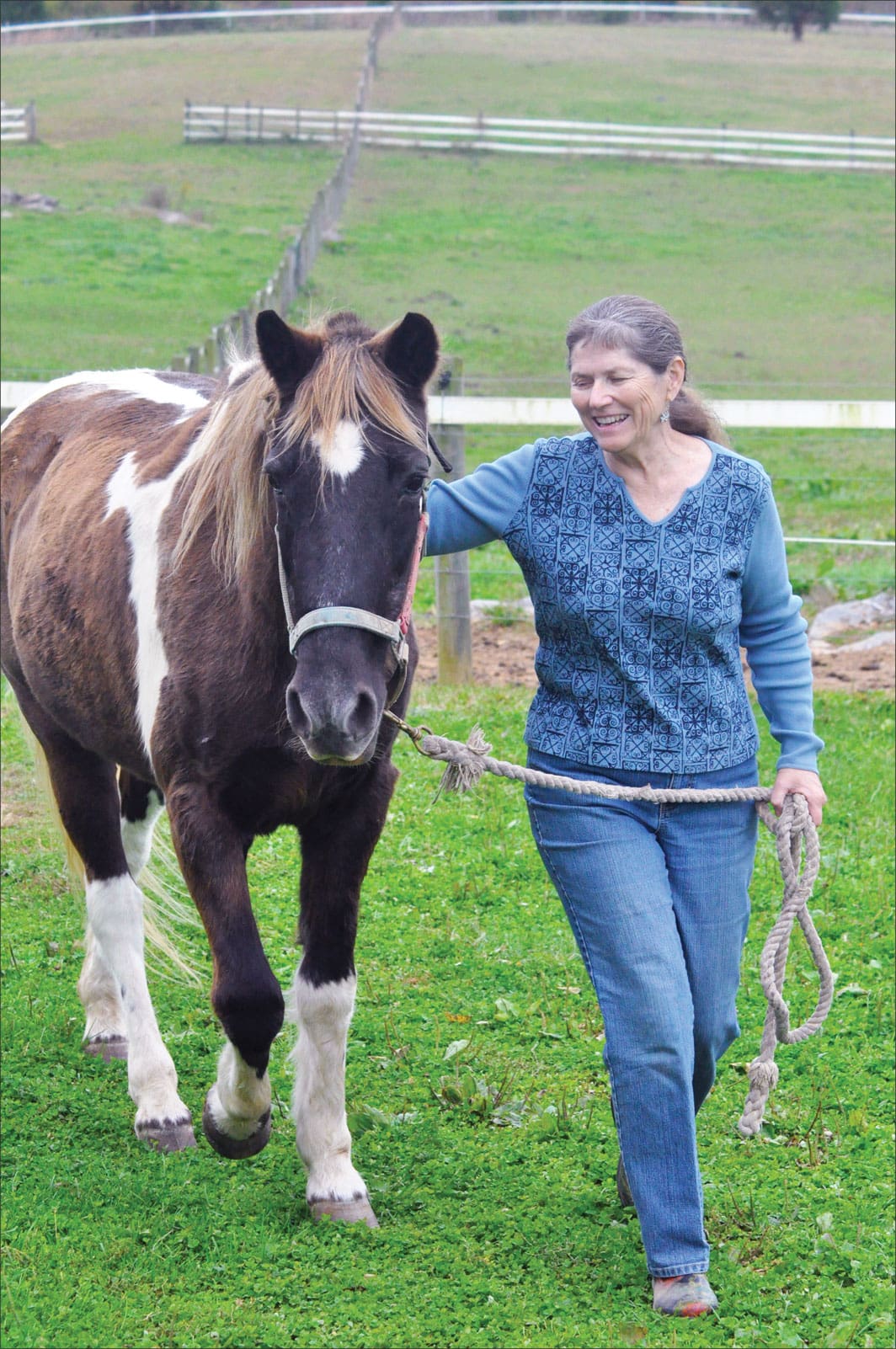Adopting a homeless dog should be a joyful process, and the beginning of a rewarding relationship. I highly recommend it. But there are pitfalls. (You knew there were going to be pitfalls, didn’t you?) Not every animal rescuer, rescue group, or shelter that is well-intentioned can back up good intentions with self-discipline, genuine animal expertise, and the organizational and people skills necessary to do a good job of placements and follow-up.
Worse, some self-proclaimed “rescues” are, in fact, straight-up swindles in which puppies and dogs are sold for a profit to unsuspecting consumers who have had their radar disarmed by being told that they are “rescuing” a homeless animal. “Rescue” swindles appear to be increasing as more potential dog owners are convinced that buying a puppy is always wrong, and that “adopting” absolves them of any responsibility for prudent consumer skepticism.
As I discussed in “Ethical Breeders” (WDJ August 2013), not every dog breeder breeds and sells puppies in an expert manner, one that promotes the welfare of dogs and their owners. Similarly, not every entity that calls itself a shelter or rescue is worthy of the smart, ethical dog consumer’s support in the form of charitable dollars, volunteer time, or adopting a dog.
Good breeders keep animal welfare foremost in their practices; this is not just ethical, but also a matter of self-interest: people want to buy healthy puppies. Likewise, ethical, competent shelters and rescue groups evaluate their animals intelligently, provide necessary medical and behavior interventions for dogs who need them, screen adopters rigorously but not rigidly, provide follow-up, and employ good fiscal and animal care management. A source like this is most likely to provide you with an adopted dog who will be a happy match for you. And supporting a source like this – with your eyes wide open and your BS radar running – helps them help even more homeless dogs.
A LITTLE HISTORY
Thirty years ago or more, it was simple to adopt a homeless dog. Your choices were limited: You went to the municipal dog pound or local animal shelter (they were often one and the same, and this is still true), walked up and down the aisles between the chain-link kennels, immersed in an ocean of hysterical barking and assailed by bad smells, and picked out a dog you liked whose stray hold had expired. You might have had to show a driver’s license.
You paid a small fee and took him home. You were on your own. If Buster bit or Bridget barked, it was up to you to figure out what to do about it. You had taken your chances in the used dog market, and there was no warranty.
In the 1980s, a new kind of dog adoption organization started to emerge. The lovers of specific breeds of dogs, alarmed and disgusted to see “their” dogs languishing in shelters, got together to pull dogs from shelters – and to step in where possible to prevent them from landing there. In some cases the rescue group was a branch of the breed club. The dogs were fostered in the private homes of people who were highly knowledgeable about the breed – often breeders, and usually long-time owners – who were well qualified to address breed-typical behavior and health issues.
A potential adopter who had her heart set on a Great Dane or Scottish Terrier might scour the local shelters for months without finding one, but a breed-specific rescue group offered a selection of them. The rescue personnel understood what kinds of homes were suitable for their breed and what kinds of difficulties a new adopter might expect.
Because they had put time and money and love into rehabbing the “rescue dogs,” the breed rescues’ criteria for adopters was typically more stringent, their application processes more extensive, and their adoption contracts more restrictive than the animal shelters’. Adoption fees were often also higher – but still far lower than the cost of a typical puppy of that breed – reflecting the rescue’s vetting costs and the value added to the dog through evaluation and training while in foster. If a new adopter experienced challenges, the dog’s foster human or another rescue volunteer was available to give advice.
The “taking care of our own” philosophy of the breed rescue movement was one of the driving forces that has changed the game of animal sheltering. Next came other kinds of targeted rescues – groups that rescued blind dogs, hunting dogs, black dogs, giant dogs, tiny dogs, orphan puppies, elderly dogs, pregnant dogs – and local rescue groups that did not specialize, that might triage out the most adoptable dogs from shelters with the highest kill rates, or the least-adoptable dogs from shelters where the highly adoptable ones were in no danger.
In 1989, when the first Project BREED directory of breed rescue groups was published, the editors stated that 90 percent of the animals who entered shelters in the U.S. left through the back door in bags. Today, a shelter that euthanizes 90 percent of its wards defines the very bottom-scrapings of the “industry” – exceptional rather than typical.
That dramatic change has been driven by many factors besides rescue groups, including the ideals of the No Kill movement, Internet networking, especially the rise of Petfinder (founded in 1996), message boards, listservers and Yahoo groups, and more recently, social media such as Facebook and Twitter.
Though sources disagree about the rates at which municipal shelters and non-profit shelters euthanize the animals that they are charged with sheltering, no one denies that both the rates and absolute numbers of pets euthanized by such agencies have plummeted, even as the human and pet population has increased.
It is tempting to call it All Good. Most shelters do a better job than they did 20 years ago, and most rescues are well-intentioned and trying hard to do right by the dogs they take in. Pet-seekers can usually get a very good dog, indeed, by adopting from a shelter or rescue.
Continue to page 2 to read about what could go wrong, as well as valuable shleter researching tips!
When a consumer is buying a microwave oven, she feels that skepticism is entirely justified. It is her right – nearly her obligation – to subject marketing claims to scrutiny. The buyer who falls hook, line, and sinker for what the super-helpful, so-nice, commissioned salesman at the store says – advice that flies in the face of that Consumer Reports review – is a sucker.
But when a potential dog owner is seeking a new little family member, and has heard the feel-good message of “rescue” over and over, she both feels as if she is Mother Teresa just because the transaction is called an adoption rather than a purchase, and as if there is something unworthy and immoral about questioning the nice people who of course are entirely selfless and only want to help the poor doggies. They call themselves Angels On Earth Orphan Rainbow Rescue; who am I to question them?
The result in too many cases, to quote one of my trainer colleagues: “Rescue is the new puppymill.”
In roughly ascending order of seriousness, adopting from an evil or just poorly run entity can result in:
– Finding yourself without any effective help or resources if you should have difficulties with your new dog, questions about care, or need help rehoming him.
– Realizing that you are a bad match for your dog because the shelter or rescue knew little about him and didn’t bother to learn much about you.
– Discovering that your newly adopted dog has dire and/or expensive health issues or very serious behavior issues that the adoption agency should have or did know about and did not address.
– Unwittingly contributing to a “rescue” or “shelter” that lines the pockets of its executives at the expense of animal care and plays wink wink, nudge nudge with the tax code.
– Supporting a rescue or shelter that transports dogs from remote locations, even importing them from other countries, quickly flips them for a profit with the help of a dramatic and exotic narrative, thereby consigning local homeless dogs, with less colorful backgrounds, to die.
– Unknowingly paying an “adoption fee” for a “rescue dog” that turns out to be an animal culled from the same person’s puppymill or brokerage and then laundered through “rescue” to improve the main commercial enterprise’s bottom line.
– Adopting a dog that had seriously attacked a human and had been taken to the shelter for euthanasia, but was offered for adoption instead, and having that dog kill you. (Short of a homicidal dog getting his dewclaws into the nuclear codes, I think that’s about as bad as it can get.)
How can you avoid being taken advantage of by a swindler posing as rescue, or (more commonly) enable, encourage, and support an incompetent, ill-managed rescue group or phoning-it-in shelter? How can you find a rescue or shelter that has your interests as a dog owner front and center, coequal with the welfare of the dogs it provides for adoption?
HOW TO RESEARCH A SHELTER OR RESCUE
The first thing to remember is that Google is your friend.
The second thing is, swindlers are sometimes smart about gaming Google results.
You need to be smarter and more resourceful, and not inhibited by any sense of what is “nice” or “too nosey.” Start with the obvious searches: The name of the organization; the name of the organization plus key words such as “fraud,” “charged,” “convicted,” “investigation,” “cruelty,” “neglect,” “complaints,” and “reviews.” Go three or four pages deep while looking at your search results.
Be aware that online review sites are unreliable. The most aggressive swindlers pack such sites (and their Facebook pages) with bogus reviews, and also solicit reviews from their marks, who post them based on how much they love their new Schmoo-a-doodle puppy who cost only $275 and is sooooo cute! Negative reviews of rescues and shelters may be based on being rejected as an adopter; you will have to judge whether those are legitimate complaints or the sour grapes of unsuitable applicants.
Also unreliable are human interest stories – fluff pieces – in local media. Getting a story in the local newspaper about the wonderful selfless dog rescuers is not difficult. Like adopters, reporters seem to lose all their critical faculties when someone claims to be the Mother Teresa of animal rescue.
Second, search on the names of the principals: the president, board president, board members, directors, “founder.” (Be especially skeptical of rescues who appear to be fully controlled by someone whose title is “founder.”) Use the key words above, and also “dog” and “puppy.”
If you cannot find the full names of any responsible people on the organization’s website, or in its annual report if it posts one (smaller organizations often do not) what does that suggest about its credibility?
If you see anything that looks suspicious in the results you get above, follow it.
If you see a lot of hits come up on Google and also on the organization’s Facebook and Twitter accounts that show a pattern of constant crisis, be very careful.
An animal shelter or rescue may leap into crisis mode and ask for emergency help (donations, foster homes, additional volunteers) when a truly emergent situation develops that strains their normal resources – the authorities raid a hoarder and the shelter suddenly has 150 terrified and sickly animals to care for at the height of kitten season, or the small breed rescue finds itself faced with 6 litters of puppies and 10 feral adults turned over by a puppymiller’s good-hearted nephew when his aunt has a stroke. It is perfectly okay for an organization, especially a smaller one, to jump into crisis mode when there is an actual emergency, one that realistically could not be planned for. They need extraordinary help during an extraordinary event.
To continue reading about shelter research tips, go to page 3!
But if the crisis is every month, and is in the nature of “They are going to turn off the electricity tomorrow and we are out of dog food again and the landlord just tacked up an eviction notice and the vet cut off our credit until we make a payment and all the puppies have bloody diarrhea,” then you are not looking at a functional, viable shelter or rescue organization. This is important to you as an adopter because such groups (or individuals) operating in a constantly reactive mode cannot provide adequate care to the animals in their custody, much less make good choices about adoptions or support you after adoption.
Now it’s time for the phone number and email searches. Google search every phone number and every email address you can find associated with the organization or individual. You are looking for newspaper and online ads and websites that link back to those numbers and addresses.
If a small rescue group’s contact phone number also pops up for a Craigslist ad offering a lawnmower for sale, that just means that the contact person is using his or her personal number. No worries.
If the rescue group runs ads for adoptions online and in print, that’s also okay. Promoting their animals for adoption is their job. You may want to read the ads – do they mention the name of the group, or are they coy about it? That can be a slightly pink flag.
If the email or phone numbers also turn up animals for sale, that merits very close scrutiny. It does not necessarily mean that the rescue is bogus. Remember, breed rescues were invented by ethical breeders, and many of them are still largely run and staffed by the best breeders, who are volunteering out of love of the breed. Someone who fosters Border Collies and sells lambs – probably not a concern. But you want to look very closely at such connections.
When in doubt – in fact, even when not in doubt – consult the breed club (local or national), local ethical breeders, and other breed rescue organizations for the same breed. If a contact pings back from a local non-breed-specific rescue to a breeder, be especially chary. If it pings back from a local rescue to a breeder of multiple breeds, or anyone who has the field marks of a puppymiller described in last month’s WDJ, you probably don’t need to investigate further; walk away.
If the phone or email turns up on ads seeking puppies or dogs, you also have your answer. Legitimate rescues and shelters don’t advertise to get puppies, and they certainly do not pay for puppies.
If your phone number/email address search turns up ads or pages that have additional contact information on them, follow those leads as well. Push those as far as they take you; someone who is trying to hide activities that are ethically incompatible with legitimate rescue may slip up by using an address or phone number for the “wrong” identity just once.
Obviously, prior criminal records or fraud or animal-welfare related civil cases that come up should send you elsewhere for your dog adoption needs.
FOLLOW THE MONEY
If the organization passes this phase of Google-fu, check their financials. Brace yourself: This is going to seem like a lot of work, but again, it’s worth all the trouble to starve the individuals and organizations who would otherwise line their own pockets at the expense of both homeless animals and the kind-hearted people who genuinely want to help them.
All but the smallest legitimate rescue organizations, and all non-governmental animal shelters, will be incorporated as 501(c)3 charitable non-profits, which means that donations to them are tax-deductible for the donors.
Please keep in mind that 501(c)3 status does not constitute a Good Dogkeeping Seal of Approval. The IRS is interested only in correct paperwork, not correct operating practices, and many poor rescues, shelters, and straight up con-men will be incorporated. But the absence of a 501(c)3 incorporation is a red flag. An organization that claims to be a 501(c)3 but cannot produce an EIN number and supporting paperwork is a huge red flag – and more common than you might believe.
Most tax-exempt charities will pop up immediately on a variety of websites if you Google the legal name of the charity and “EIN.” When looking on sites such as nonprofitstats.com and nonprofitfacts.com, you may find that contact information and other details are incorrect or out of date; this is not a particular worry.
Now, search for the organization’s most recent 990 forms – the tax return that charitable non-profits must file with the IRS. The group should be able to provide you with a copy upon request.
A small organization (less than $25,000 in donations) is permitted to file just a brief “postcard” return, the 990N. Some small organizations will choose, for transparency and to help get grants from foundations, to file a more detailed return, the two-page 990EZ or long form 990 that is required of organizations with larger incomes – the bigger local shelters and high-profile national groups.
You can find many 990s on Guidestar.org (which requires you to register for a free account) or Foundationcenter.org. Or a Google search for the organization’s name + 990 may bring it up elsewhere. It’s a good sign if it is on the organization’s own website.
A guide to closely parsing 990 forms is a book in itself. Smart direct-mail mills with expensive lawyers and accountants have many ways of hiding their bloated fundraising expenses, executive salaries and benefits, shady nepotistic consulting payouts, and other evidence that they are exploiting a narrative about the poor animals rather than engaging in genuine rescue work. It can take an expert to spot problems in those long-form returns, but generally, you want to look at executive salaries, consulting fees, fundraising expenses, “education” costs, and expenses for things such as vehicles and rent.
Large organizations being mined for revenue by their officers will tend to show six-figure salaries for one or more executives, extremely generous benefits and pensions, and high consulting fees relative to their income. The consultants are often friends and relatives of officers and board members. Fundraising costs that get plowed back into for-profit fundraising firms with connections to the charity’s board or officers (never generating income for animal care or other legitimate programs) may be concealed under the line item “education.”
Small 501(c)3 organizations that serve as cash-cows for their principals may also pay salaries, or the money transfer from tax-deductible donations and “adoption fees” will be hidden in other ways: “rent,” “boarding expenses,” “training expenses,” “consulting.” The rent and kennel bills being paid, for example, to the executive director who operates the adoptions out of her house, with “rent” equaling her mortgage and utility payments, the “training” fees paid to her daughter, and the “consulting” being performed by her husband – but they all have different surnames, and you only discover the relationship with some devoted Googling.
Vehicle and transport expenses are another thing to look at; are volunteers being reimbursed the usual and customary rate for fuel, or is the president getting a new truck every two years, paid for by the charity?
Shady finances are not only an ethical problem; they are indicative of people who do not have your best interests as an adopter at heart, and for whom animal welfare cannot be top priority. They are people who are stealing money from the donors and the dogs, and want to steal some of yours while assuring you that you are a virtuous person for “rescuing” your new pet.
Continue to page 4 to read about what standards & practices to look out for!
Let’s hope your prospective source for a rescue dog clears the bar for evidence of racketeering and fiscal incompetence.
Your last set of questions before deciding to pursue adopting from a rescue or shelter should be: How well are they doing the job of animal rescue?
Your last set of questions before deciding to pursue adopting from a rescue or shelter should be: How well are they doing the job of animal rescue?
– First, look at what they require of you. Is their application reasonably detailed, and aimed at finding out what kind of home you would provide, with questions that will give them a clear picture of you and your expectations, abilities, and environment?
– Do they conduct an interview with you in which they explore your answers to the application questions in a reasonable way? (A shorter application and a more detailed interview or interviews are okay, and can be the sign of a flexible organization, more common among small rescues.)
– Do they require references (personal and veterinary) and then actually talk to those people and ask them intelligent questions about your character, abilities, other animals?
– Do they have a strong, clearly worded, enforceable adoption contract that lays out your responsibilities toward the dog, and that requires that you return the dog to the rescue or get permission from them to rehome him (with a new contract for the new owner, even if it is a family member) if you ever cannot keep him?
– Are adoption fees reasonable and customary? Does the group reveal its fees, or do they have a separate (often secret) “price tag” for each animal based on how desirable they think it is? It’s not uncommon to have higher fees for puppies and lower or no fees for elderly or special-needs animals, but when the prices start looking like the stickers on the windshields at Bob’s Really Good Used Cars, we have left the realm of charitable work.
– If you get even the slightest sense of a hard-sell, the impression that the group would let you have any of their animals as long as you paid the fee, you should probably walk away.
– A good litmus test is to ask yourself, “If I was diagnosed with a life-threatening illness and had to return this dog to the rescue group in a year and knew they would be choosing his new owner the same way they chose me, would I be confident that my beloved pet would get a great home?” If you can’t answer yes to that question, get out of there.
– Then, what do they provide to the dogs? Is the dog vaccinated, tested for common problems such as heartworms, treated for parasites, and has he received any necessary diagnostics and treatment for illnesses and injuries? If the dog is an adult or older puppy, has he been neutered? If a young puppy, is there a neuter deposit that you will not get back until you provide proof of sterilization?
– If the shelter/rescue provides little of the above, it should charge little or nothing for an adoption. One of the main jobs of legitimate rescues that pull from shelters is to provide that vetting before placing the dog for adoption.
– You should not expect even a well-heeled shelter or rescue to perform every possible health test on every dog. Your adopted Rottweiler will likely not have been x-rayed to see if she has hip dysplasia or spondylosis.
But by the same token, if the rescue or shelter knows that she is limping and has done nothing to find the cause, you could be in for a huge unplanned expense. At minimum, the shelter or rescue should provide full disclosure of the dog’s observed symptoms. Some rescues will cover vet bills for adopters who knowingly and with eyes wide open take a dog who needs ongoing treatment (say, heartworm treatment) – it works for them, as the dog isn’t taking up foster space during a long recovery. Some may retain ownership in a foster-to-adopt arrangement until the treatment is complete. Larger local shelters may provide the treatment at their own clinics or by their contract veterinarian.
– Similarly, are the dogs evaluated by shelter workers and/or foster humans for temperament, behavior, and training needs? Do the descriptions of the dogs provide useful information, or are they all just fuzzy little buddies looking for someone to love them? It’s okay for a Petfinder profile to put a mostly positive spin on a dog, but that’s not the same thing as concealing known problems, avoiding knowing, or flipping dogs so fast that the rescue personnel have no idea what the dog’s temperament may be like.
– Dogs and puppies transported en masse from the deep south to the coasts, and from rural areas to urban, and “placed” directly off the truck are at particularly high risk for communicable disease and undetected temperament issues.
– Does the shelter – and especially a foster-based rescue – add value by training, rehabbing, and socializing the dogs as necessary and appropriate? If “foster home” just means “a place to store the dog in a crate stacked in the garage with a dozen others,” then neither you nor the dog has been well-served by “rescue” as opposed to a $20 direct adoption from a rural shelter.
SUPPORTING THE REAL DO-GOODERS
Once you are aware that there is such a thing as a “bad” animal shelter or rescue organization, it’s incumbent on you to support only the good ones. You can do this in at least three important ways: You can contribute money. You can volunteer. And you can choose to adopt. If every one of us made it a personal policy to research rigorously and support only those groups who are adopting out homeless animals in such a manner that we wish every shelter and rescue would follow the same practices, then corrupt, incompetent, and frankly criminal “rescue” enterprises would disappear overnight. Dogs and those who own them would all be better off for it.
Heather Houlahan lives with her husband and other creatures on a small farm near Pittsburgh, Pennsylvania, has been a search and rescue dog handler and trainer for 22 years, and is the proprietor of First Friend Dog Training. Houlahan both breeds the occasional litter of working English Shepherds and is behavior coordinator and a foster human for National English Shepherd Rescue. She blogs at cynography.blogspot.com.















 Charlie Sunde and his wife, Kolleen, own Nutrition Coalition in Fargo, North Dakota, a leading retail source for Willard Water. According to Charlie Sunde, Willard first developed what he called the “Clear Formula” of his catalyst-altered water. In an attempt to add nutrients extracted from lignite coal, which contains the fossilized remains of prehistoric vegetation, he then developed a formula he called XXX (or Triple X), which he regarded as valuable due to those nutrients but weaker in effect than the original Clear formula. Still later, he developed a formula now known as Ultimate (previously known as Dark XLR-8 Plus), which he considered equal in strength to the Clear and containing the minerals and nutrients he thought to be present in the Triple X. Recent studies published on the company’s website support Willard’s conclusions. In a test of nutrient absorption by plants, the Ultimate formula could be diluted four to eight times more than the Clear or XXX formulas and still perform as well as or better than either. Another study analyzed Willard Water’s ability to boost absorption of nutrients at the cellular level. “What’s especially interesting,” says Sunde, “is that it seemed most effective at increasing the most-difficult-to-absorb nutrients, which is in keeping with what Doc Willard always told us.” Another effect that sets Willard Water apart from other products, Sunde adds, is its ability to permanently improve the pH of water by making it more alkaline, which is said to have a beneficial effect on overall health. “Most ‘alkaline waters’ remain alkaline for only a matter of hours or days before they lose their increased alkalinity,” says Sunde. “A new study explains how water’s pH is permanently changed by Willard Water. I don’t think the study mentions this, but Doc actually tested some diluted Willard Water that was 15 years old and the pH was the same as when it was made.” All three formulas are still being sold, but Nutrition Coalition is the only source of the Ultimate (or Dark XLR-8 Plus) formula. “Doc wanted it that way,” says Sunde, “to protect his favorite formula from the problems less-than-ethical marketers had created with the Clear and XXX versions, and his sons and now his grandchildren have continued that arrangement. We are the only source of the Ultimate for stores that wish to carry it and the only distributor for retail sales other than the manufacturer, CAW Industries. Dealers can sell the Ultimate, but any firm or store selling the Ultimate has to get it from us.” One fluid ounce (2 tablespoons) of the concentrate per gallon of water is the strength recommended for daily human consumption as well as for topical application on pets and people. This same strength is a good daily drinking water for animals with acute or chronic health problems or for any animals during hot weather or times of stress. (Note that these recommendations are for Ultimate Willard Water. The greatly diluted Dark XXX product requires 2¼ times the amounts listed here.) Start with less than the recommended amount, and increase gradually. If your dog develops diarrhea or other symptoms of detoxification, reduce the amount until symptoms disappear and then resume as normal. The recommended maintenance water for healthy dogs, cats, and other animals not under stress is far more dilute, such as 1/3 ounce (2 teaspoons) concentrate per gallon of water. Use this solution to fill your dog’s water bowl, which should be available at all times. Also add it to dry, canned, or raw food. In her book Holistic Guide for a Healthy Dog, Wendy Volhard, another longtime user of Willard Water, recommends adding diluted Willard Water to your dog’s drinking water when traveling to keep stress levels under control. “Taking your own supply of drinking water is preferable,” she says, “but if that is not possible, use what is available on your trip and add 2 tablespoons of diluted Willard Water to each bowl, so that your dog is not affected by the change.” For our 2006 article, we interviewed Roger DeHaan, DVM, a holistic veterinarian in Kings Mountain, North Carolina, who has recommended Willard Water for his canine patients since 1983. He mixes the liquid concentrate with drinking water for improved hydration and applies it to cuts, wounds, and other injuries. He even adds a small amount (10 cc) of full-strength concentrate to each liter of Lactated Ringers Solution before administering subcutaneous fluids. To use Willard Water topically, dilute 2 teaspoons concentrate in 1 quart water or use 2 tablespoons per gallon. Use this solution as a wash or rinse to clean and treat cuts, burns, wounds, or abrasions. Pour it directly on the affected area or use a spray bottle. Repeat the application several times per day. Spray or apply it to sprains, bruises, trauma injuries, arthritic joints, and any area that is swollen or tender. Volhard swears by Willard Water as a hot spot treatment. “It dries up the inflamed areas overnight,” she says. “I also spray it on cuts to stop the bleeding and on insect bites to reduce the swelling and irritation.” To improve your dog’s coat, spray it with diluted Willard Water before brushing or grooming. Willard Water helps prevent dander, freshens the coat, and helps most dogs smell better. Increase the effectiveness of your dog’s shampoo by mixing 1/4 cup shampoo with 1 cup diluted Willard Water. According to users who reported their results to Dr. Willard, this actually helps calm excitable or nervous show animals. If you use a conditioner, which may no longer be necessary as Willard Water has a conditioning effect, mix it at the same proportions. Finish with a final rinse of dilute Willard Water solution or an herbal tea made with diluted Willard Water. To treat any eye condition, spray diluted Willard Water directly into the dog’s eye. Willard Water helps clear up conjunctivitis and other infections, and it’s an effective first-aid rinse for the removal of debris. Clear Willard Water concentrate is often recommended for use in the eyes, but many users report excellent results from rinsing or spraying eyes with dark Willard Water solutions. If desired, add a pinch of unrefined sea salt to make the solution slightly salty. Tears are saline, and adding a small amount of salt makes the solution more comfortable. Whenever you brush your dog’s teeth or give her a tooth-cleaning rope toy to chew on, spray the toothbrush or toy with diluted Willard Water. Diluted Willard Water can be used as an ear cleaner, too, or you can add a few drops of full-strength concentrate to any liquid ear cleaner. Willard Water helps the solution reach farther and loosen wax and debris. Nutrition Coalition also sells Aqua Gel, a blend of Willard Water, aloe vera, and vitamin E for topical application on burns, insect bites or stings, bruises, sore muscles, skin conditions like eczema or psoriasis, and hot spots; Chinota Gel, a blend of Willard Water and Chinese herbs for muscle aches and arthritis pain; and Very Natural Willard Water Soap made with Willard Water, olive oil, coconut oil, and glycerin. This non-irritating bar soap is a favorite of most who try it. For more about Willard Water’s many uses, see “
Charlie Sunde and his wife, Kolleen, own Nutrition Coalition in Fargo, North Dakota, a leading retail source for Willard Water. According to Charlie Sunde, Willard first developed what he called the “Clear Formula” of his catalyst-altered water. In an attempt to add nutrients extracted from lignite coal, which contains the fossilized remains of prehistoric vegetation, he then developed a formula he called XXX (or Triple X), which he regarded as valuable due to those nutrients but weaker in effect than the original Clear formula. Still later, he developed a formula now known as Ultimate (previously known as Dark XLR-8 Plus), which he considered equal in strength to the Clear and containing the minerals and nutrients he thought to be present in the Triple X. Recent studies published on the company’s website support Willard’s conclusions. In a test of nutrient absorption by plants, the Ultimate formula could be diluted four to eight times more than the Clear or XXX formulas and still perform as well as or better than either. Another study analyzed Willard Water’s ability to boost absorption of nutrients at the cellular level. “What’s especially interesting,” says Sunde, “is that it seemed most effective at increasing the most-difficult-to-absorb nutrients, which is in keeping with what Doc Willard always told us.” Another effect that sets Willard Water apart from other products, Sunde adds, is its ability to permanently improve the pH of water by making it more alkaline, which is said to have a beneficial effect on overall health. “Most ‘alkaline waters’ remain alkaline for only a matter of hours or days before they lose their increased alkalinity,” says Sunde. “A new study explains how water’s pH is permanently changed by Willard Water. I don’t think the study mentions this, but Doc actually tested some diluted Willard Water that was 15 years old and the pH was the same as when it was made.” All three formulas are still being sold, but Nutrition Coalition is the only source of the Ultimate (or Dark XLR-8 Plus) formula. “Doc wanted it that way,” says Sunde, “to protect his favorite formula from the problems less-than-ethical marketers had created with the Clear and XXX versions, and his sons and now his grandchildren have continued that arrangement. We are the only source of the Ultimate for stores that wish to carry it and the only distributor for retail sales other than the manufacturer, CAW Industries. Dealers can sell the Ultimate, but any firm or store selling the Ultimate has to get it from us.” One fluid ounce (2 tablespoons) of the concentrate per gallon of water is the strength recommended for daily human consumption as well as for topical application on pets and people. This same strength is a good daily drinking water for animals with acute or chronic health problems or for any animals during hot weather or times of stress. (Note that these recommendations are for Ultimate Willard Water. The greatly diluted Dark XXX product requires 2¼ times the amounts listed here.) Start with less than the recommended amount, and increase gradually. If your dog develops diarrhea or other symptoms of detoxification, reduce the amount until symptoms disappear and then resume as normal. The recommended maintenance water for healthy dogs, cats, and other animals not under stress is far more dilute, such as 1/3 ounce (2 teaspoons) concentrate per gallon of water. Use this solution to fill your dog’s water bowl, which should be available at all times. Also add it to dry, canned, or raw food. In her book Holistic Guide for a Healthy Dog, Wendy Volhard, another longtime user of Willard Water, recommends adding diluted Willard Water to your dog’s drinking water when traveling to keep stress levels under control. “Taking your own supply of drinking water is preferable,” she says, “but if that is not possible, use what is available on your trip and add 2 tablespoons of diluted Willard Water to each bowl, so that your dog is not affected by the change.” For our 2006 article, we interviewed Roger DeHaan, DVM, a holistic veterinarian in Kings Mountain, North Carolina, who has recommended Willard Water for his canine patients since 1983. He mixes the liquid concentrate with drinking water for improved hydration and applies it to cuts, wounds, and other injuries. He even adds a small amount (10 cc) of full-strength concentrate to each liter of Lactated Ringers Solution before administering subcutaneous fluids. To use Willard Water topically, dilute 2 teaspoons concentrate in 1 quart water or use 2 tablespoons per gallon. Use this solution as a wash or rinse to clean and treat cuts, burns, wounds, or abrasions. Pour it directly on the affected area or use a spray bottle. Repeat the application several times per day. Spray or apply it to sprains, bruises, trauma injuries, arthritic joints, and any area that is swollen or tender. Volhard swears by Willard Water as a hot spot treatment. “It dries up the inflamed areas overnight,” she says. “I also spray it on cuts to stop the bleeding and on insect bites to reduce the swelling and irritation.” To improve your dog’s coat, spray it with diluted Willard Water before brushing or grooming. Willard Water helps prevent dander, freshens the coat, and helps most dogs smell better. Increase the effectiveness of your dog’s shampoo by mixing 1/4 cup shampoo with 1 cup diluted Willard Water. According to users who reported their results to Dr. Willard, this actually helps calm excitable or nervous show animals. If you use a conditioner, which may no longer be necessary as Willard Water has a conditioning effect, mix it at the same proportions. Finish with a final rinse of dilute Willard Water solution or an herbal tea made with diluted Willard Water. To treat any eye condition, spray diluted Willard Water directly into the dog’s eye. Willard Water helps clear up conjunctivitis and other infections, and it’s an effective first-aid rinse for the removal of debris. Clear Willard Water concentrate is often recommended for use in the eyes, but many users report excellent results from rinsing or spraying eyes with dark Willard Water solutions. If desired, add a pinch of unrefined sea salt to make the solution slightly salty. Tears are saline, and adding a small amount of salt makes the solution more comfortable. Whenever you brush your dog’s teeth or give her a tooth-cleaning rope toy to chew on, spray the toothbrush or toy with diluted Willard Water. Diluted Willard Water can be used as an ear cleaner, too, or you can add a few drops of full-strength concentrate to any liquid ear cleaner. Willard Water helps the solution reach farther and loosen wax and debris. Nutrition Coalition also sells Aqua Gel, a blend of Willard Water, aloe vera, and vitamin E for topical application on burns, insect bites or stings, bruises, sore muscles, skin conditions like eczema or psoriasis, and hot spots; Chinota Gel, a blend of Willard Water and Chinese herbs for muscle aches and arthritis pain; and Very Natural Willard Water Soap made with Willard Water, olive oil, coconut oil, and glycerin. This non-irritating bar soap is a favorite of most who try it. For more about Willard Water’s many uses, see “